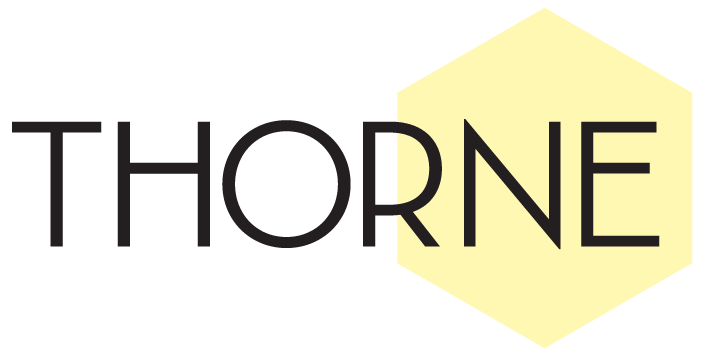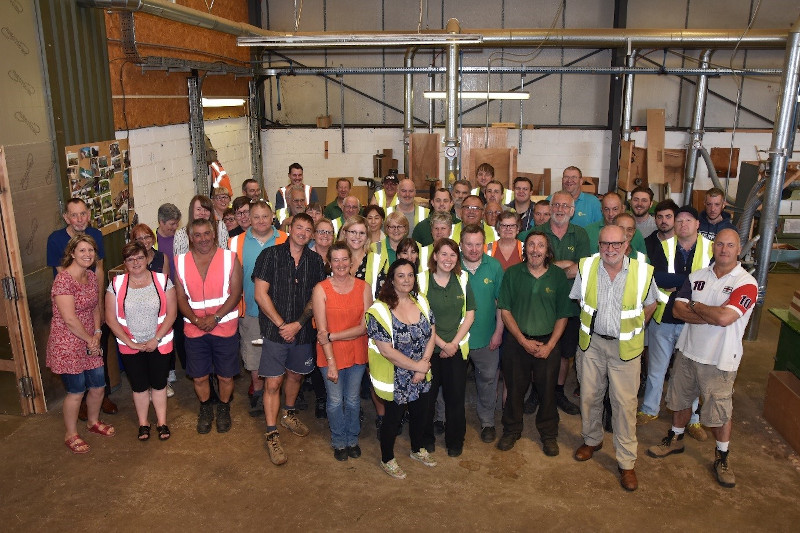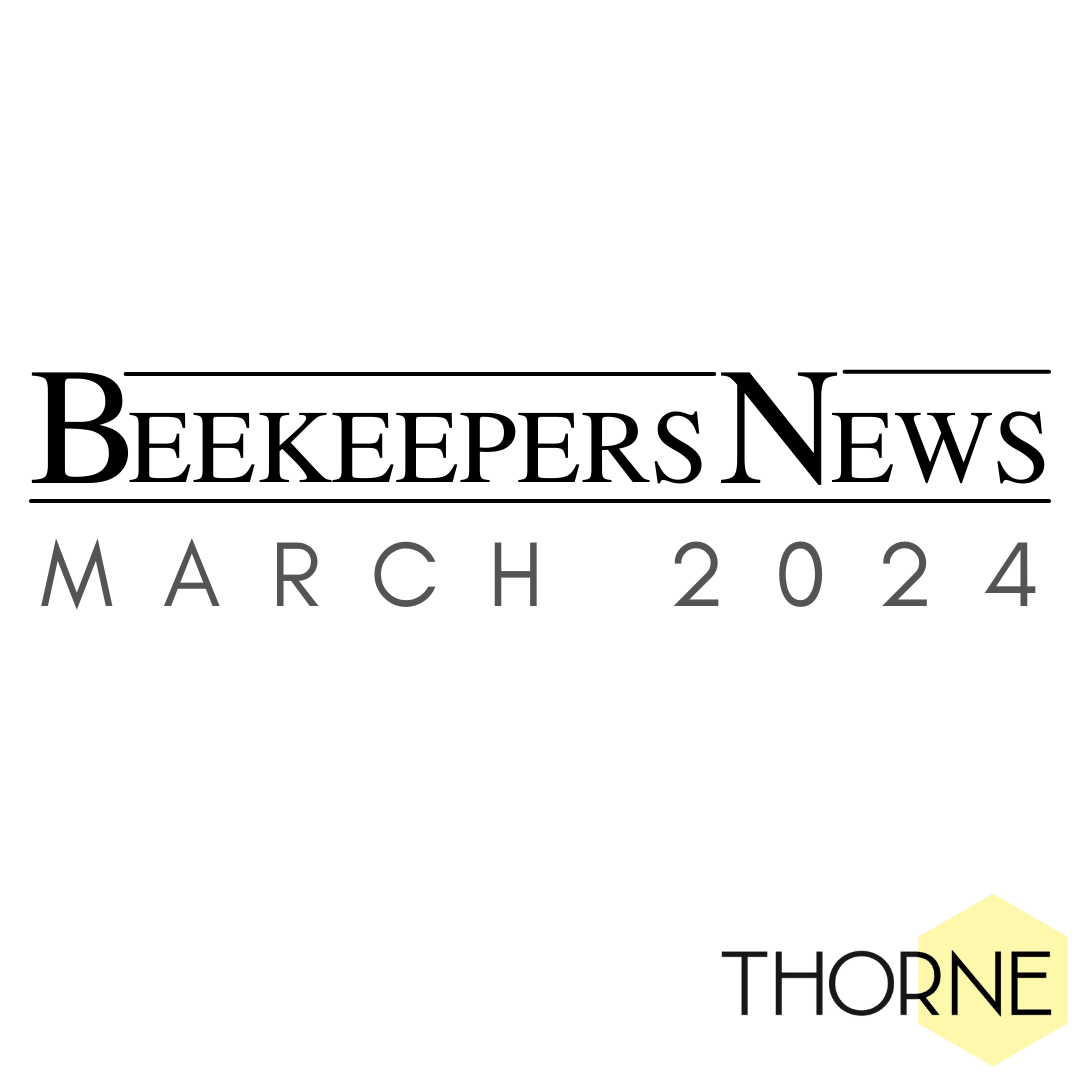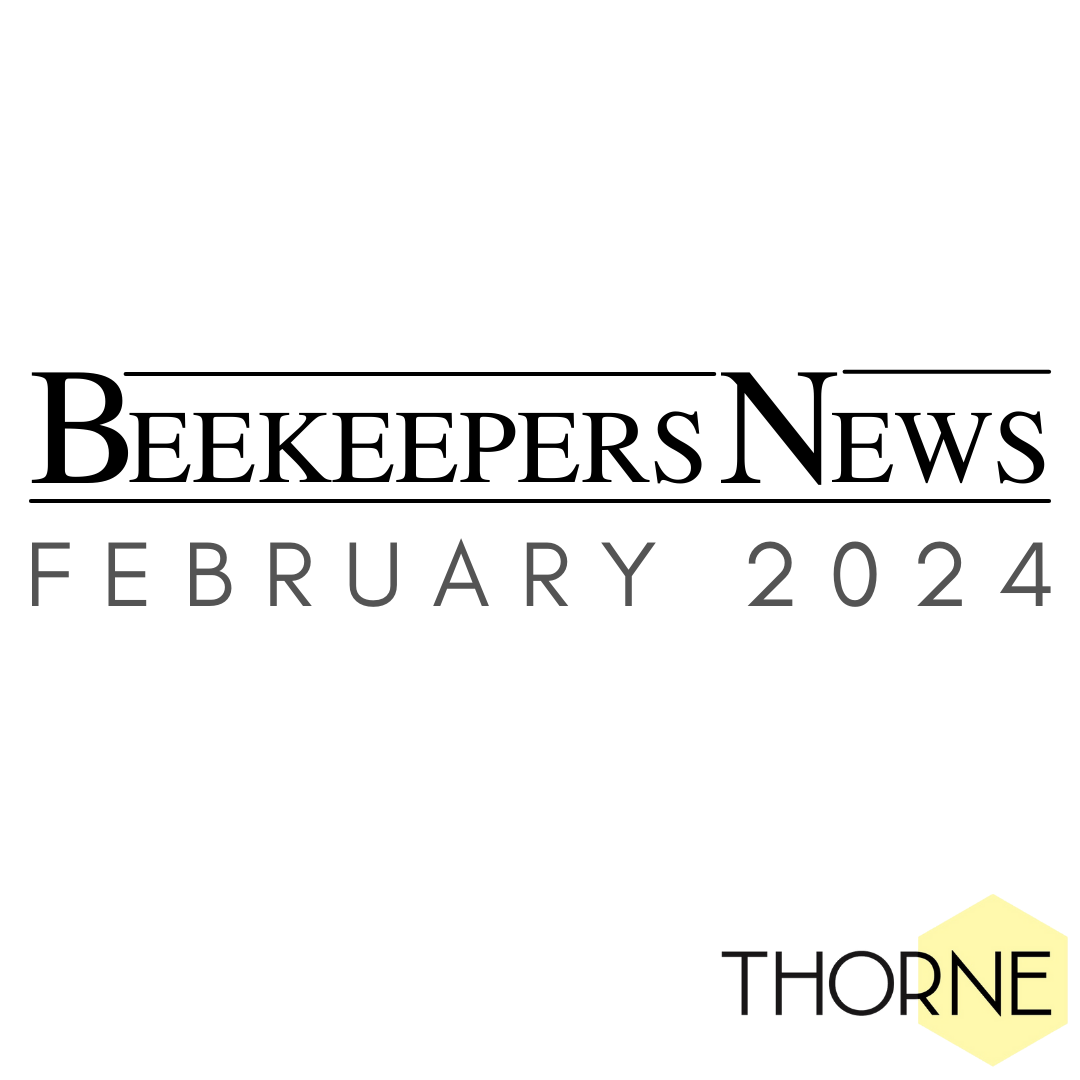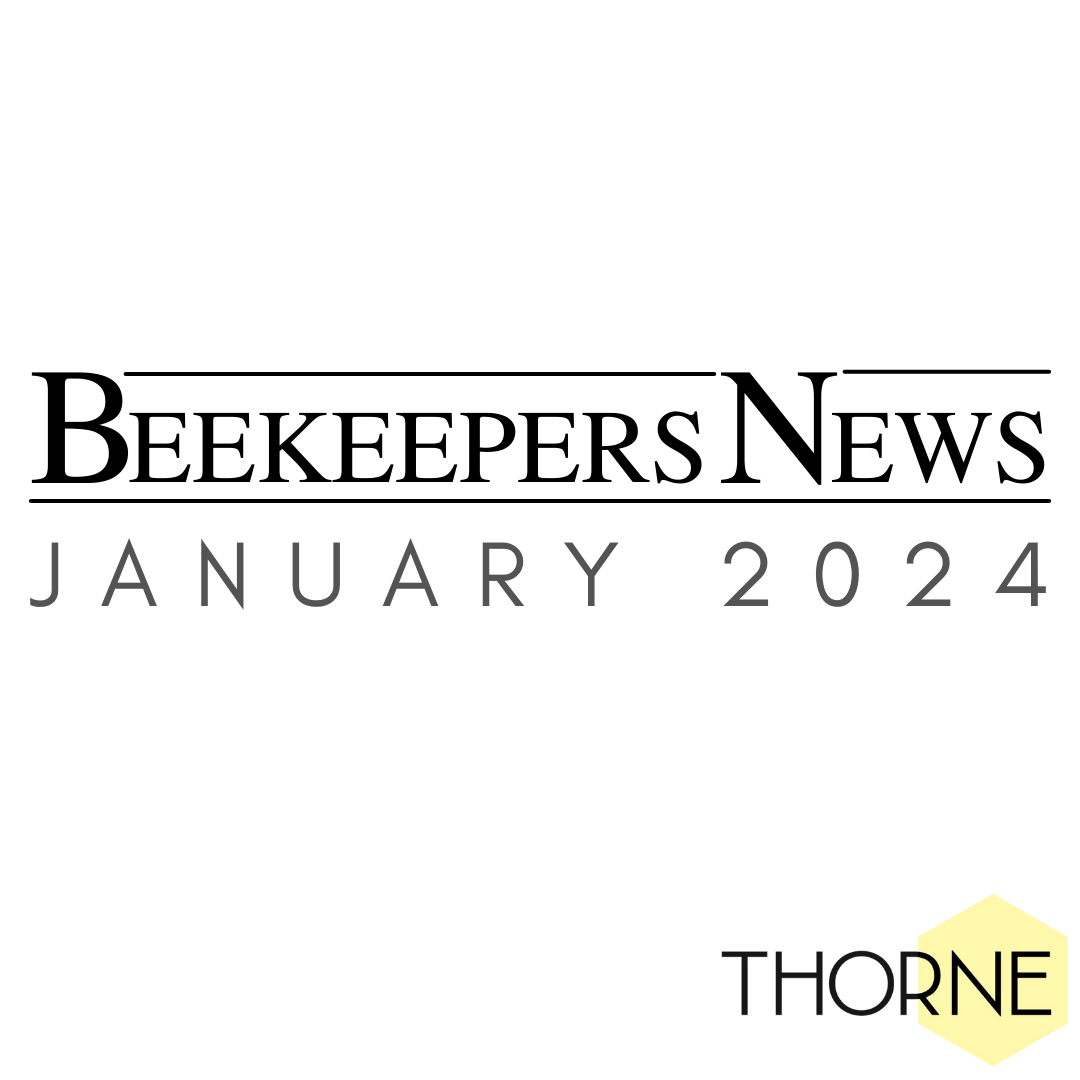July Roundup
July seems to have passed in a hot and humid flash. After the short June gap it seemed that all our customers were keen for equipment to make the most out of the warm weather we were enjoying. We have had hundreds of orders for personalised honey labels. Many are from beginner beekeepers who were delighted to be harvesting their first ever crop of honey.
Our ever popular branch sale days will soon be upon us. You can now order online, or over the phone, bargains for collection only, from our Scotland, Windsor, Stockbridge, Devon and Rand Sale Days. You could even order for collection from the National Honey Show. See www.thorne.co.uk/sale-days for more details.
At the beginning of July we wished John Bellamy a happy retirement (shown on the front row third from the right next to our MD, Paul). John was a senior member of our workshop, and if you have any Langstroth, Commercial, Dadant or Smith hives it is quite likely that John had a hand in making them. Here are a few of our staff wishing him well.

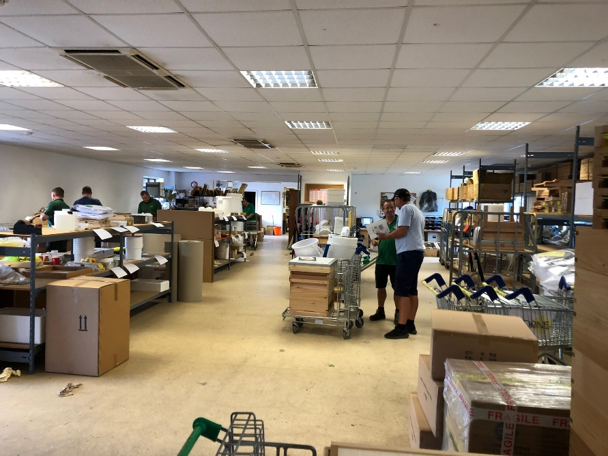
Huge congratulations to Molly Hatcher who works in our ‘Buzz Stop’ restaurant. Molly has completed her Catering Level 2 Apprenticeship and now joins us as a fulltime member of the team. Why not pop into the restaurant next time you are here at our Rand head office??
Some of our staff have been busy rearranging our despatch department this month. This will make better use of the space and ensure your orders reach you even more efficiently.
We were delighted to be involved with the ‘Bee in the City’ project undertaken by the Manchester & District Beekeepers Association earlier this year. The MDBKA have sponsored one of the amazing bees that have been placed around the city this summer. For more details see https://bit.ly/2v0f1bl.
The picture shows Lena Crowe (MDBKA President) and the artist Peter Davis with the association’s bee sculpture.

Let us know if you are planning a training course in the next few months and we can add the details to our website. We have memory sticks available which you could use for course notes or important information. Please email rebecca@thorne.co.uk if you would like one for each of your students.
Equipment Focus………
Clearing Bees with Chemicals
Clearing bees with chemicals and a fume board has long been the tool of choice for many beekeepers especially if they were/are running a commercial operation.
Carbolic Acid was probably the first chemical to be used widely throughout the world, especially in Australia and the USA in the 1930’s. It worked well under the right conditions but sometimes failed if temperatures were too low. The risks to the beekeeper however were huge! It was carcinogenic, caused severe burns and one drop in the eye could cause blindness. The USDA soon latched on to the dangers of Carbolic Acid and banned its use. We do not think it is used widely today if at all.
An alternative was needed therefore to help with clearing of supers and after research by the USDA Propionic Anhydride entered the market in the early 60’s. It proved very successful yet it too was susceptible to failure if temperatures were not consistently high. It was also still a pretty dangerous substance as far as the beekeeper was concerned.
Leslie Thorne, son of the founder of Thornes, as well as being a beekeeper and equipment manufacturer was also a freelance 16mm cameraman, often working for ITV. With his film making skills he produced a small film on the use of Propionic Anhydride which won the film award at the 1963 Apimondia Congress in Prague.
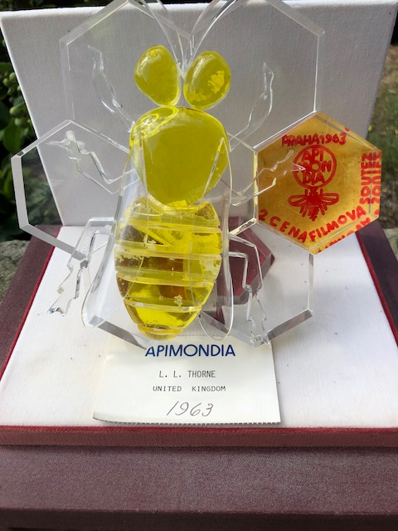
Further research was carried out for yet another clearing chemical that was not so temperature sensitive. Benzaldehyde was the result, it was also known as artificial almonds and was used as flavouring in food stuffs. However, it did have drawbacks. It was so volatile in high temperatures that it virtually drugged the bees and they stayed on the comb in a trancelike state! It too has since been withdrawn from use.
So now we come to Bee Quick. This product from the USA is now used world wide and is recognised as probably the most efficient and safest of chemical clearing agents. It is a non-toxic blend of natural oils and herb extracts, available in 236ml (£13.50) or 3.8 litre (£120.00) bottles.
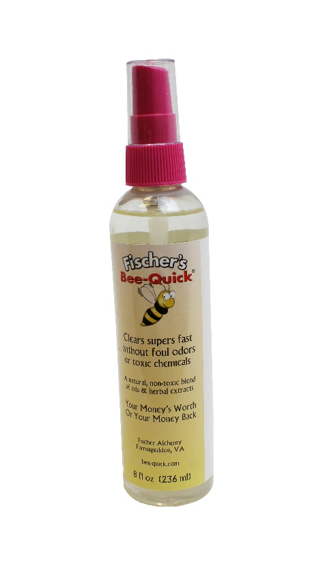
It is very effective and easy to use with either a fume board or simply a soaked cloth or absorbent card (beer mat material). Once the soaked cards or cloth have been placed on the top bars the supers should be cleared after approximately four minutes. A fume board (£16.90) is a 40mm wooden frame with an absorbent cloth stretched over it, similar to a painters canvas. The cloth is sprayed with Bee Quick in a zig-zag motion. Once totally covered a thin steel cover is placed over the cloth. Heat from the sun soon warms the steel and begins to vaporise the Bee Quick. The heavier than air vapours soon fall through the hive causing the bees to rapidly exit the supers.

Apivar
Have you taken your last super off for the year and are your bees ready for the Autumn treatment? Consider using Apivar. One pack will treat five hives, it is not temperature dependent and can be used at the same time as Autumn feeding. Apivar costs £31.
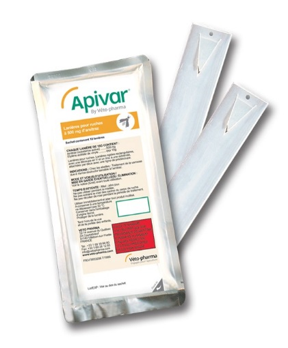
Ask our Expert
This month we hear from Tony Jefferson of Whitby and Yorkshire Beekeepers Associations. We asked him what you needed to do to produce a good crop of Heather Honey.
Heather Honey
When asked to produce this article I thought it would be a good idea to explain how we organise our year of beekeeping, in preparation for two weeks of anticipated good weather in August. If you decide to take bees to the heather sufficient preparation needs to be done to maximise the effort involved.
There are basically two types of heather honey; Bell heather (my personal favourite) which flowers from July onwards and is a dark coloured, liquid honey which can be extracted normally. Ling heather flowers later in August and produces thixotropic honey so getting it from the comb to the jar is not straight forward.
Location considerations
When placing bees on the moors, advance reconnaissance is vital to ensure the hives do not pose any problems to the gamekeepers and beaters, and others who may use the land, such as walkers and picnickers. Other important site assessments include the amount of shelter from the wind and the chances of flooding.
The location for placing hives on the moors is known as a heather stance. However, an ideal location is difficult to find and co-operation with the land owners is vital. The young shoots that are formed after the last season's heather have been burnt off are the ones which are good for nectar production. A managed moor is therefore essential as long, leggy heather yields very little nectar.
Also consider potential problems arising from local wildlife, such as sheep who could knock hives over or snakes who could pose a risk to beekeepers. Position the hives directly on the ground without hive stands, but with some thin plywood in front of the hive to prevent grass growing over the entrance and space them about two 'sheep distances' apart. Sheep like to scratch their backs on the corners of hives so if they are placed directly on the ground and strapped up they are less prone to being knocked over. When taking hives off the moors snakes are often found underneath so gloves and care are required. I often see hives positioned near main roads and the bees have to fly over the road where many are hit by passing traffic or literally ‘run over’, so do give some consideration to road locations.
Use healthy, robust bees
My beekeeping is based around breeding the dark bee, Apis mellifera mellifera, as I believe these to be well-suited to the harsh environment and periods of high work on the heather moors, due to their good productivity at low temperatures. The weather on the moor can change dramatically from warm days to very cold nights, and these bees seem to be able to withstand such temperature variations as well as long periods of confinement and reduced egg-laying which can result. They also show good recovery when taken off the moors, making them a good species to work with.
When best to take bees to the moors
Times do vary but it is anticipated the heather should yield nectar following ‘The Glorious 12th ‘(of August), the start of the traditional grouse shooting period. Seasonal variations do occur but the aim is to have plenty of foraging bees available for this period. This means plenty of eggs need to be laid six weeks prior to the beginning of August (i.e. mid-June) this period falls right in the middle of the usual ‘June gap’ so stimulative feeding with 1:1 syrup, i.e. thin syrup, is usually needed during June.
Preparing bees for the moors
There is little point in taking small hives to the heather so the aim is to have colonies on a minimum of ten frames of brood. I use brood and a half and no queen excluders and those who know the ‘Jefferson way’ will realise we vigorously argue the benefits. If your colonies are smaller than this consider uniting the small colonies to get plenty of bees.
Manipulation of brood in early June, before taking them to the heather, is required to get good heather-gathering colonies. From early June spread the centre of the brood nest and place at least one, more if a strong colony, of empty drawn comb in the centre to get lots of eggs. The old brood on the outside will ensure any honey is stored in the supers, so no queen excluder is needed. At this stage producing eggs is the major consideration, the stimulative feed should continue and there is likely to be plenty of pollen available during the June gap, if not nectar. During the week prior to moving to the heather stance, the young brood is moved to the outside (reverse of above) the older brood is now in the centre and this will emerge first while on the moor. The Queen will then re-lay in these cells to produce ‘winter’ bees. The young brood on the outside makes sure the honey goes in the top. The reason for not using queen excluders is that the queen’s laying rate will already be reducing at this time of year and every egg produced is likely to be needed for the winter bees.
Prior to moving them any sealed summer honey is removed; if any is unsealed it can be placed on other colonies or left on the top of the hives that are going to the moor. Put supers on each hive prior to moving as plenty of space is required for the bees to expand in transit. A general rule is, add one super for every box of brood, so if using a brood and half then add two empty supers. You will give your bees a good start in their honey production if you provide them with drawn super combs. Remember it takes at least 8lb of honey to produce 1lb of beeswax, so drawing out comb on the earlier crops should be carried out. Drawing out thin super or even starter strips when on the moors, will lose lots of valuable heather honey.
Maintain high levels of insulation while the hives are on the moor due to the cold nights, as it takes less energy for the bees to ventilate and cool the hives than it does to keep them warm. The honey will be ripened and sealed much quicker if top insulation is provided.
Our floor boards are our own version of the ‘heather’ floors which were sold by Steele and Brodie. These are flat floors that have a funnel type entrance with the bees entering from below. This has major advantages as the funnel is an internal alighting board so bees do not get blown away and there is room for the bees to cluster in the funnel to aid fanning and ventilation for honey ripening. The major advantage of the funnel is that a foam block is easily inserted for moving the hives.
Transporting the bees
When moving the hives to the heather consider the transport to be used, e.g. a car, van or trailer, as minimum stress is the aim, and trailers give the bees a very harsh ride.
Strap the boxes together securely; use a couple of straps if unsure. I dislike the spring fastenings and toggles that are available; they are fiddly to operate. Consider moving the hives in the early morning to get them there before 7am. Things do go wrong and contingencies, such as daylight, 50mm ‘gaffer’ tape and spray deterrents (Apifuge) are useful as the smoker will almost certainly be out. Wear a bee suit as a precaution and have gloves available. For those who have not yet managed to dislodge boxes or drop a hive when moving it, you have done well; it will occur at some stage!
Provided you have given them empty supers then full top mesh travelling screens are not required for a trip of up to fifty miles. Too much top ventilation can agitate the bees, but make sure they are kept in the dark by placing some hessian sacks over the top. I use a piece of varroa mesh pinned over the porter bee escape hole on the glass quilt, and this is adequate ventilation. On arriving on the moor position the hives directly onto steady ground and leave the bees to settle for five to ten minutes before removing the foam entrance blocks. I count the foam strips to make sure they are all removed. Leave the straps on so they are protected from wind and sheep.
Maximising the crop
When on the moor and the weather is fine and the heather is flowering well, there is always the temptation to add more supers. This can be counterproductive as it is far better to get one or two full, capped supers than three or four that are only half capped. To maximise the crop, move the sealed frames to the outside and the unsealed to the middle. At this stage, if the weather is good then, rather than adding a full super, a few sealed frames can be removed and more unsealed can be added in the centre.
Prolonged cold and/or wet weather can occur while on the moor and starvation can arise very quickly. So, if the weather has been poor check the hives, because large colonies can starve to death in a matter of a couple of days; feeding on the moor is not un-heard of.
Taking off the honey and returning the bees
Assuming a good crop of honey has been gathered then the next stage is to get some removed, processed and the bees back home and set up for winter. Removing large hives full of honey is not easy due to the weight, so it is likely that the supers will need to be removed. The best method is to use clearer boards as robbing by other bees occurs very easily, especially at the end of a flow when the colonies are still strong. Brushing, shaking or blowing off bees to clear frames is to be avoided.
Rapid clearing can be ensured if there is a clear space below and above the porter bee escape. In a National hive having eleven frames the porter escape is in the centre, and it is best to remove the centre frame, then clearing in 24 hours will be likely. Remember if there is any brood in the frames to be removed these will not be cleared as the nurse bees will not leave the brood. As expansion space is needed for the trip home, leave a super in place.
Honey processing
Processing the honey has a few options. Traditionally the comb is cut from the frame and pressed out. Presses are difficult to locate and are quite expensive items, but most associations have one available to loan to members. For small amounts consider scraping back to the foundation so that the foundation is preserved for the following season. The scrapings can go into a vacuum type filter unit (VF Mini Strainer); the vacuum soon pulls the honey through as long as a little-and-often amount is placed in the strainer.
We have a big advantage of having a heather loosener which enables us to spin out the frames using a tangential extractor. The frames must be put in the extractor the correct way; the bottom bar needs to face the direction of travel. The loosener, although initially expensive, is a brilliant piece of equipment as it saves drawn comb for the next season as well as lots of time in rewaxing frames in the spring.
Heather honey is thick (thixotropic) and difficult to fine filter. It is therefore difficult to remove wax pieces when preparing it for showing, unless pressed through fine filter cloth.
Leaving only heather on the hives as a winter food often results in dysentery around Christmas time. If there has been a poor ivy nectar flow, then feeding with thick syrup in the autumn and fondant from the beginning of November assists in providing a more balanced supply of food over the winter.
I am a firm believer that the ambient temperature for varroa control with thymol-based products is not really an issue as long as the hive is reduced to a single brood box before feeding for winter and then applying the varroa treatment directly at the brood area; the heat of the small amount of brood is sufficient for the thymol to operate. Our thymol treatment is applied into October as it also knocks down more adult mites.
Winter maintenance
All that is needed over winter is to keep an eye on the hives every two weeks to replenish any fondant that have been used. Meanwhile watch for the first pollen to become available; normally this is the pussy willow catkins and small clumps of snowdrops. Then a floor change is carried out to remove mouseguards. If left in place, they strip the vital incoming pollen off the bees. Then a stimulative, 1:1 feed of syrup in contact feeders is started to make sure the queens start to lay.
In the north, our first inspections are never carried out until after Easter. Then we are back to where we started this article, working hard all year round for two weeks of decent weather in August and our honey crop. We often wonder why, but the honey is such a highly prized product that all the effort is worth it when we put lots of thick, high aroma, wonderfully strong tasting honey in jars and buckets ready to go out for sale. However, in 2012 we had to reminisce about this last point, as there was not much to look at.
Tony Jefferson, Whitby / Yorkshire BKA
For more information about producing a crop of heather honey see Tony’s book ‘A Practical Guide to Producing Heather Honey’.
Beekeeping Blog
July
What a scorcher July has been! It has been an uncomfortable beekeeping month due to the unrelenting hot weather which has also contributed to the bees’ increasingly bad mood.
On trying to requeen a rather nasty colony, I needed some help lifting the heavy boxes so recruited one of our despatch guys to help. In my hastiness, I told him to come out as quickly as possible so when he turned up, he wasn’t wearing any wellies and had his ankles showing. This was a big mistake as the bees found his ankles and stung him several times. Luckily, he did not react to the stings and was back out to help within a few minutes – this time with parcel tape around his ankles! This is not recommended but it did the job. Unfortunately, I did not get chance to take a photo.
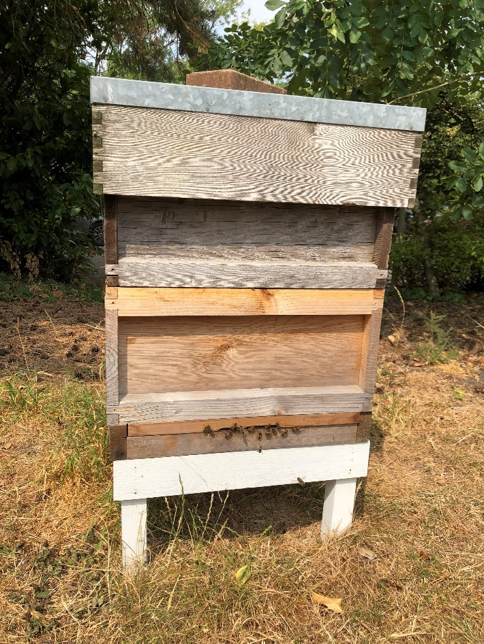
This month we have also introduced some queens for those colonies that were suffering a little from old queens or those whom had undesirable traits. These were introduced using a simple queen introduction cage with fondant. These have been left in the hives for the workers to eat through the fondant towards the queen. Once they reach her, they will hopefully accept her as their new queen.
With this hot weather we have seen the early arrival of wasps. They hang around under hive roofs and will go after any spilled honey or syrup so it is especially important to keep apiaries clean and tidy to avoid encouraging them into the apiary. For this reason, entrance blocks have been fitted to reduce the risk of wasps finding their way into a hive unchallenged.
Here’s hoping we get some rain soon!
If you require any more information, please send an email to Alexandra at sasha@thorne.co.uk who will be happy to help or call one of our sales team on 01673 858555.
Bees for Development Update
Amazing news! We are delighted to announce that BfD has been given a £50,000 grant by the Govt’s DFID UK Aid, as part of the Small Charities Challenge. This is to support our continued work in Ethiopia, where the honey and beeswax produced by Ethiopian bees is helping to generate income for beekeepers across the country.
Penny Mordaunt, International Development Secretary said:
‘Bees for Development is a splendid example of how a small organisation in Wales is helping to make a huge difference in Ethiopia. They are providing an invaluable entrepreneurial experience to young people, helping them thrive and support their own community.’
Alun Cairns, Secretary of State for Wales said:
‘I am delighted that the hard work of the charity Bees for Development is being rewarded for the international impact they have in encouraging entrepreneurship in a way that protects our environment. I hope that the funds awarded will go a long way to continue the great work they do across Ethiopia.’
The Project was selected for its ability to strengthen the capacity of grassroot organisations working with the most marginalised people - to ensure that no one is left behind.
The Small Charities Challenge Fund was launched in 2017 specifically to provide funding to smaller charities with an income of £250,000 or less. Bees for Development is the first recipient to be announced from the first round. Other successful applicants will be announced later in the year.
If you would like to see the impact of BfD’s work in Ethiopia, then you are warmly invited to join our special Bee Safari taking place in November, more details here https://bit.ly/2LEE2mO
The picture shows Derbanta Youth Beekeeping Cooperative members: (L-R) Tena Getachew, Zemenawi Animaw and Alemnesh Nigiru with jars of their honey
Winner of the July Birthday Giveaway
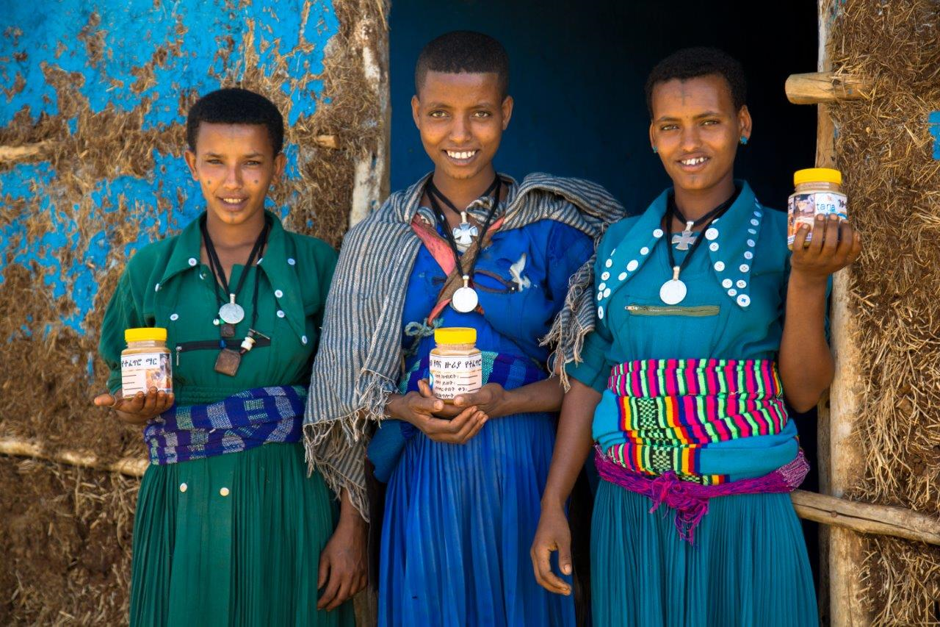
Scott Dwyer is the winner of July’s adventurous prize – a copy of Tom Seeley’s book Following the wild bees, signed by both the author and the book’s designer, and in addition a beautiful Bee Box, hand-made from 40 year old Durham Black Walnut, kindly donated by Megan Denver of Hudson Valley Bee Supply.
Bees for Development 25th Birthday - August Giveaway
Jean-Luc Colombo is a family-run winery in the Northern Rhône Valley in France. Producing extremely high quality, organic certified, sustainably made wines, Jean-Luc Colombo has forged an international reputation as one of the most visionary winemakers in the Rhône Valley. Jean-Luc Colombo says: “My passion is to create wines that give people pleasure. I want each glass to be remembered for their statement of quality”. The Colombo family are beekeepers too and harvest their own honey as well as wine.
Les Abeilles (the bees) is a blend of red southern Rhone grapes (33% Grenache, 34% Syrah and 33% Mourvèdre) from 25-year-old vines growing in the Côtes du Rhône region’s ancient, terraced vineyards. This medium-bodied, velvety red wine has aromas of red fruit, liquorice and spice against a backdrop of smooth, silky tannins. Good to enjoy anytime!
Our luxurious Birthday Giveaway prize for August is a case of six bottles of this special wine, generously donated by Hatch Mansfield www.hatchmansfield.com who import Jean-Luc Colombo wines to the UK. For your chance to win this super prize, just follow this link: http://www.beesfordevelopment.org/giveaway/index.html
National Honey Show News
The National Honey Show Schedule is due to go to press any minute now so will be ready to be sent out very soon. If you are a member or join in the next few weeks you will receive a copy in the post. The contents will also be available on the website. In fact some details are “up” already: check out the lecture programme and entry classes, and there are a couple of new workshops for this year. These are bookable on line from 1st September.
It’s just up to the bees and then your presentation skills now to make it the best show ever. We’ll look forward to seeing you there.
The National Honey Show, 25 to 27 October 2018, Sandown Park Racecourse, Esher, KT10 9AJ www.honeyshow.co.uk.
Upcoming Events
Sale items to order for collection at the branch sale days and National Honey Show are live on our website – www.thorne.co.uk/sale-days
Scotland Sale Days Friday 10th and Saturday 11th August
Windsor Sale Day Saturday 8th September
Stockbridge Sale day Saturday 15th September
Devon Sale Day Saturday 29th September
Rand Open and Sale Day Saturday 13th October
National Honey Show 25th to 27th October
